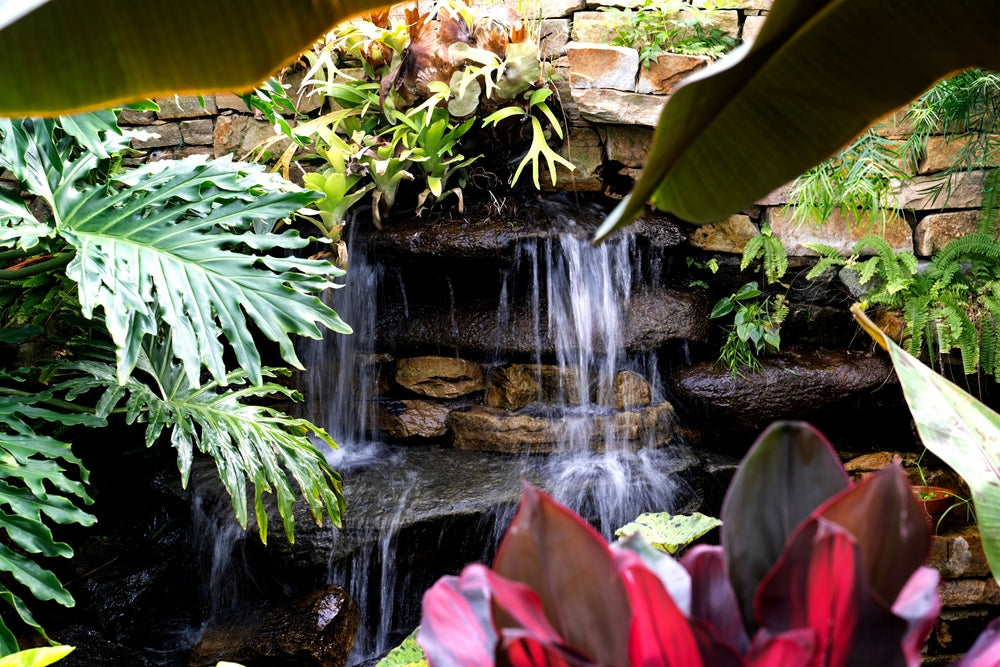How to Create a Waterfall in Your Vivarium

Few things are as striking as the sight and sound of flowing water. And when you can capture that magic in an indoor space, that is the ultimate luxury, right? If you’re here, that probably means that you saw a waterfall in someone else’s terrarium and thought, wow, I want something that looks like that in my own home! This article is specific to (and a very brief introduction to) terrarium aquascaping. There are multiple methods of building terrarium waterfalls. The one we’re outlining here is a fairly simple approach that should be quite compatible with a bioactive reptile or amphibian setup. Generally speaking, waterfalls are more compatible with amphibian vivariums than reptiles, but it’s not impossible.
Pros and Cons of Terrarium Waterfalls:
Pros
- Helps maintain higher levels of humidity for temperate and tropical setups
- May encourage reptiles to drink more water
- Elevates the aesthetic value of your terrarium
- Can provide soothing water sounds
Cons
- Increases vivarium maintenance
- May present a health hazard if hygiene standards are not met
- May saturate the substrate
- May cause reptile health complications related to excessive moisture
Can a waterfall work in a desert vivarium?
Many keepers of arid and semi-arid reptiles complain of difficulties with convincing them to drink, and a commonly recommended solution is to provide moving water in the setup. This can make installing a water feature in your desert vivarium very tempting! However, due to the fact that you would need an underground reservoir of water and the way moving water tends to increase ambient humidity levels, it’s generally too risky to include a waterfall when designing an arid indoor environment. You also risk increasing the substrate’s moisture content beyond that which is tolerated by arid plants such as cacti and succulents.
That being said, an exception may be made in the case of particularly large and/or well-ventilated enclosures when the water feature occupies a relatively small portion of the overall space, and there is sufficient ventilation and space for a wide humidity gradient.
What do you need to build a vivarium waterfall?
In addition to your usual supplies for assembling a bioactive terrarium, you will need the following:
Water pump and tubing: This is essential to keeping the water flowing and guiding the flow from the reservoir to the top of the waterfall. Water pumps are rated by flow rate, so make sure to choose one powerful enough to make it to the top of the waterfall and create the effect you want without splashing everywhere. Most terrarium waterfalls don’t require a particularly high flow rate, but it’s a good idea to experiment with pumps before installing it in your vivarium.
Water pump housing: To prevent debris from clogging up your water pump (which will become very difficult to access and maintain once the enclosure has been fully set up), it’s best to place the pump inside a container that lets water in, but keeps everything else out.
PVC pipe: Although not strictly necessary, using PVC pipe to house your pump tubing is a good way to create the waterfall’s baseline structure and provide a sturdy foundation to build the rest of it around.
Adhesive: Spray foam such as Great Stuff is a popular choice for DIY terrarium décor, and works well as an affordable and easy-to-use medium for building the shape of your waterfall around its PVC skeleton. It’s also a good choice if you want to integrate the water feature with the vivarium’s background. Instacrete putty is another option for sticking natural materials together and dries faster than Great Stuff.
Decorative accents: Natural materials like rocks, wood, and even plant pots are a good way to make your waterfall look more realistic, and embed easily into wet spray foam. You can integrate these with colored grout to increase the natural appearance.
If your rocks are going to come in direct contact with the water, avoid rocks with a metallic sheen or may contain iron, copper, or sulfur, as these will negatively affect water quality. Also avoid rocks that contain salt or crumble easily, like sandstone. Pumice (lava rock) and slate are two types of rock that can work great in waterfalls!
When choosing wood for your waterfall, look for dense, water-resistant types unlikely to mold or degrade quickly. Mopani works particularly well for this purpose. However, do note that Mopani contains tannins that can leach into the water and naturally dye it a tea color.
How to Build a Vivarium Waterfall
Start with an empty terrarium – it’s much easier to start with a blank slate than to try to add a waterfall to an existing setup!
Once you know how much space you have to work with, you can sketch the layout. Choose where you want the waterfall to start and end, and where in the enclosure you want it to be. Generally speaking, it’s best to place a waterfall at the back or along a side wall.
Then decide how you want it to look, as this will affect the building materials you will need to gather. It helps to do some research to figure out what you like and what’s realistic for your skillset and the enclosure you want to install it in. Looking at pictures and watching videos of terrarium waterfalls is a good way to get a feel for what you want. After you have an idea of what you want and have gathered the necessary materials, start experimenting with different configurations of those materials until you’ve figured out how to put them together in a way that you like. If you’re new to waterfall building, it’s best to go simpler rather than more complex. As you practice and gain more experience, you can try your hand at more elaborate waterfalls later!
Now you’re ready to start building. Start with the pump and reservoir. Place the pump inside its housing, which is easy to DIY with a disposable plastic storage container and lid, with a cutout in the top for the tubing and another cutout in the side, covered with mesh hot-glued in place to let water in. Then thread the tubing through a framework of small PVC pipe with an exit point at the desired height.
Place your drainage layer material around the pump. In a bioactive enclosure, your waterfall’s reservoir will be the drainage layer, so while 2” is usually enough for the average bioactive setup, you’ll want 4” or more to make sure there’s enough available water to keep the pump going. You can use Bio Dude Hydrogrow for a more natural look, or if you’d rather reduce the total weight of your setup, Bio Dude Supergrow is a great alternative. Assemble the PVC frame for your waterfall and thread the tubing through all the way to the top. Place your drainage layer barrier mesh on top of the drainage material.
Then it’s time to build around the PVC to create your waterfall’s visual aspect. If you want to be able to remove the waterfall and pump later as needed, make sure not to let your choice of adhesive come into contact with the terrarium wall. Insert your choice of décor items into the wet adhesive and let dry. Once dry, fill your drainage layer with water, preferably reverse-osmosis or distilled. Then turn on your pump to see how your waterfall is functioning. (You may need to add extra water once the pump is running.) Fine-tune the path of the water by adding or subtracting material until you’ve achieved the look that you want, and let dry.
Now it’s time to cover the adhesive with something to make the waterfall look more natural; grout works well for a stone look, while silicone and coconut fiber or peat moss work well for a more earthy look. Once dry, give it a quick wipe down with a damp cloth or vacuum to remove loose particles.
- Note: Do not wash unused grout (even thin grout) down your household drains. Grout can stick to your pipes and create a stubborn clog!
Build the rest of your bioactive around the waterfall. Create a basin at the base of the waterfall to receive the water and deliver it back to the drainage layer. This can be a hole straight down to the mesh, or you can fill it with river rock or pebbles (the latter is a good idea if you’re concerned about drowning). Whatever you do, make sure to leave at least 2” inches of space between the water’s landing area and the edge of the drainage “pool” so that splashing water does not waterlog the terrestrial area.” If desired, you can also add an ultrasonic fogger puck to the top or base of the waterfall to create an attractive fog effect and further boost ambient humidity.
Once your bioactive enclosure and waterfall are all set up, let them cycle for at least 1 month to allow the plants, microfauna, and natural filtration to get established before introducing your pet. 3 months of cycling or more is preferable.
Vivarium Waterfall Maintenance Tips
- Check the water level daily and add more as needed. It’s very important not to let your pump run dry, as this can ruin the pump! It can also lead to stagnation and sepsis.
- Perform routine water changes. Adding more water is not the same as changing out the water, as removing about 30% of the water from your waterfall every 2-4 weeks actively reduces the concentration of pathogens. To remove water, redirect the waterfall’s flow into a bucket. To replace water, pour it into the waterfall’s drain.
- Scrub off algae. This one’s optional, depending on whether you mind the appearance of algae. Shading the waterfall with strategic planting can help “starve” algae of light and decrease the amount that grows.
Do terrarium waterfalls need a filter?
The idea of using a waterfall with a bioactive enclosure is that your soil, barrier, and plant roots should all work together to create a natural filter for your water. This should keep it fairly fresh, clean, and free of contaminants. However, since it takes a while for the plants and beneficial bacteria to establish themselves to function as a filter, it’s extra important to let your vivarium cycle for >1 month (at least 3 months is better to practice) before introducing your pet.
What if the water starts to stink?
This means that your water reservoir has gone septic and isn’t getting enough oxygenation (oxygen kills the offending bacteria). In this case, you have to completely remove the contaminated water and may even need to replace the drainage material. However, this can generally be prevented by keeping your waterfall running at all times, as the flow of water keeps it in contact with the air, oxygenating it and keeping stinky bacteria in check. Increasing the flow rate helps prevent stagnation, too.
Conclusion
The art of building terrarium waterfalls can be challenging at first, but with patient effort, you will be rewarded with a stunning and relaxing miniature water feature. Who knows — maybe you’ll even discover a new hobby!
You can simplify the waterfall build process with The Dude's complete drainage layer waterfall kit! This all-in-one kit is designed to be used with the Dude's HydroGrow V2.
Written for The Bio Dude by Mariah Healey, ReptiFiles.com
- Rebekah Walenta










